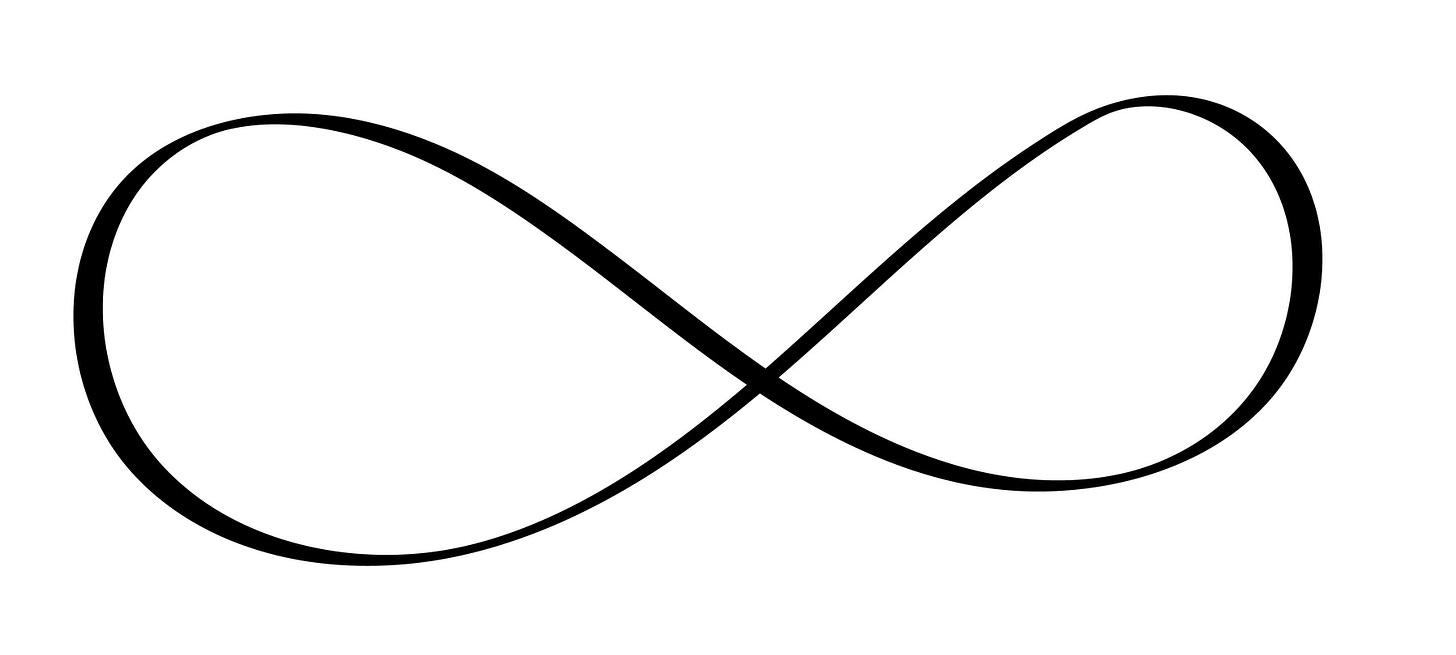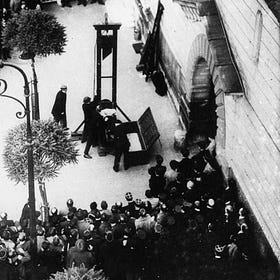Introduction
This series of Martin’s early works comes from my initial question of how his thinking developed, which led us to do rough translations of his major works into Englisch as he patiently began shepherding me through his thought labyrinth. In the process of our conversations, we noticed our little project held the possibility of bringing Martin’s thought labyrinth into relief for international readers – in particular, how it could give them access to a different kind of language helpful for understanding what seems so enigmatically unsolvable in our Modern World. And as one thing always leads to another, we eventually started our Ex nihilo Salon as a way of presenting the various leitmotifs of Burckhardtian thinking by posting translations of his early works, an Éducation Sentimentale series on how his thinking developed, along with essays reflecting his current thinking, and a series of conversational interviews with intellectuals about our enigmatic Age – all presented in what’s becoming the new publishing paradigm reflecting how mediality is consumed by digital natives. And what we felt most importantly was an underlying commitment to doing our work with an eye on moving the modern world’s conversation forward toward a positive future.
In the introductions and translator’s notes of all our postings, we’ve alluded to the Universal Machine and its Psychotope as the major, if not core, leitmotif of Burckhardtian thinking that’s contained in our following translation. What’s so important about this essay is how it reflects the moment Martin’s thinking took a radical turn away from his peers. So far, in tracing the development of his unique schematic robe, we’ve looked at four works. Digital Metaphysics was the foundation of the simulacral digital sign and the impressionistic beginning threads of all his future thinking, while In Working Memory, he explored the differences between the rationality of human imagination and that of the computer, their respective notions of temporal spatiality and the impact of this on human work. In From the Abuse Value, he began exploring the social implications of this shift using the slogan ‘Time is Money is Time’ with its economic shifting of value production from material objects to the immateriality of our attention. Then, in The Monster and its Telematic Guillotine, he presciently described the full effects of this shift that have become our current experience of the attention economy.
In between the first two essays and the latter two lies Die Universale Maschine1, published in 1990 by a 33-year-old Martin, written from the perspective of an Electric Writer in a very concise manner that begins by using Heideggerian thinking in his questioning, contrary to popular thinking of the time, if it’s possible the computer isn’t a tool but a workshop space which he’d already started describing in his earlier essays. He then lays out the possibility that it’s one in a series of Universal Machines that, while not having a direct product, provides the cultural Social Drive and defining Psychotope driving a particular age’s modes of production – and we also are already finding his movement into what Heidegger declared as the ‘end of philosophy and the beginning of thinking’ but wasn’t able to think through completely. Picking up on a theme in Digital Metaphysics, he’s now thinking beyond Foucault’s meditation on ‘power and potency’ as he questions the then-burgeoning trans-humanism movement – and vitalism’s insidious way of pervading Modernity’s thinking, particularly how a Cartesian misreading of the Universal Machine’s defrauding of nature results in its domination under this strange effeminate form that English readers can recognize as Mother Nature with her Natural Sciences Laws. In particular, how digitalization was forming a sort of unholy alliance with biology that was subtly becoming this odd chimera of neural machine circuits transparently transforming the Human into a Maschine rather than modeling machine function on human form. And there’s also this beginning critique of Post-Modernity’s relativism as a destruction of our social reality’s foundation which grounds our metaphysical being as the veiling that allows us to view the field of the real’s uncanny [das Unheimliche] Abyssal Truth, all intertwined with the beginning threads of what will become the leitmotif in his mature thinking as the dividuum of self-identity lying at the root of our current discontent with Modernity’s digital form.
— Hopkins Stanley and Martin Burckhardt
The Universal Machine
(first published in Merkur 12/1990)
A workshop with a few objects lying around in its workspace. A few of them are tools of some kind, but only one is visible: a hammer. The philosopher's2 main idea is every tool disappears behind its absorption in the process of using it as it dissolves in its around-ness, that it loses its for-selfness in its transparency, that its objective [Um-zu3] self-identity as a tool is silenced within its referential character: being part of the workshop. It’s only in this mode-of-deficiency, where the tool is missing, defective, outdated, or not yet present – it’s only in the disturbance of a workshop’s smooth functioning that a tool’s for-selfness is relieved-out as belonging to the workshop – as being integral to the ensemble of objects that now, for the first time, refer to each other in their underlying order. And then, when in the blink of an eye [Augenblick], the stuff scattered around turns into a Sign, the workshop also becomes visible as a prospectus of a particular understanding of the world: that techné as a description of the world, has always preceded technology4. This fundamental idea of Praxis is concealed from itself, becoming more veiled as it’s absorbed and caught up in everyday life. Only in a rupturus deficiency – in an abrupt asymmetrical breakage in the world – is the inner structure of the Sign character of things revealed.
This design’s boldness becomes even more visible when you see how Heidegger transposes this model with a subordinate clause and the utmost matter-of-factness to language, to the sign-stuff [Zeichen-Zeug5], as it is called in his diction. So here, in contemplation of a merely technical context, an essential nexus of his Philosophy is revealed – namely, that particular dialectical debate of speech and silence, with which, after all, Heidegger pervaded above all French poststructuralism.6
Is the Heideggerian model helpful in illuminating the emergence of what’s probably the most important tool of this century: the computer?7 It isn't so much about the moral-social dimension, nor the question about its dosing and under which conditions the computer is appropriately used, but only the crackling rift that announces this new toolkit – the diffuse rupturing expectations oscillating8 between heaven and hell as an eloquent and meaningless proof, as an indication only that something must have happened. Because the computer isn’t a tool at all in the Heideggerian sense, or at least not one of which a hammer is exemplary. If its function is exhausted in hammering, then the question of the computer's objective can’t be clarified with certainty – but defined only with a respective program running or turning it, as the case may be, into a calculator, a word processor, or an electronic drawing pen. In this sense, the term computer is a linguistic misnomer. Instead, we should be speaking genealogically of its mathematical fathers, of a Turing or Von Neumann Machine – functionally, of a Machine for symbolic manipulation – or, perhaps more simply and appropriately: a Universal Machine. However this question is decided, there remains the paradox that there’s no objective, no particular purpose associating itself with the computer. In a sense, this all-purpose machine refuses the economic rationalizing structure of dialectic synthesis according to which what’s new, once it’s transferred into use, loses its Sign character, becoming transformed into a hardly noticed means of production – only appearing as an organ that’s become defective and unusable, as a symbol of what’s been overcome, of what’s surpassed.9 Perhaps this is the reason for the computer’s particularly persistent presence and symbolic power in mass culture products with this ubiquitous, almost compulsive humanization – as if only the stereotype of a Big Brother or the ‘computer colleague’ could bridge its alien emanations; a gesture only fluctuating between clumsy familiarity and obeisant reverence – precisely tracing the pattern of that other myth: that inconspicuous employee who, at the right moment, turns into a Superman. And, perhaps, the businessman’s whisperings about these new technologies who knows nothing of this century's fairy tales --- but all-the-while eagerly falls for them, also draws his justification for belief from here. Undoubtedly, the computer is not comparable to the airplane, the gasoline engine, or the steam engine, but it’s a something else – a tool of an entirely different technology. Perhaps, if it existed, it would be something like the Archetypical Machine – a Machine that generates a whole generation of new Machines in its image: a Birthing Machine.
If there’s a historical analogy, then it's the Mechanical Clock, that tool which we find at the beginning of the Modern Age, perhaps even marking its beginning since it posed the ‘conditions of the possibility’ for the emergence of classical physics and the exact sciences. This similarity may not seem clear since the conception of Absolute Time, whose only measurement tool is the clock, has become transparently a second nature to us. But, as this conception’s collapse in 20th-century physics proved, it’s actually the other way round – the creation of an absolute conception of time is the product of its technical realizability, thus a consequence of its measuring instrument. The Mechanical Clock, which symbolically ‘wound up’ on church towers in the late Middle Ages, was, without doubt, a Machine that didn’t satisfy the immediate needs of production – rather, it referred to itself and its immanent quality of a World-Time as running autonomously independent of the observer which, incidentally, distinguished it from previous conventional methods of time measurement. In this sense, the Mechanical Clock’s core of the analogy lacked a historical objective that is a definitive end-point of producing a physical product. Instead, it created a Universal Concept of an Absolute Time that could be broken down into precisely measurable individual parts and segments – opening up access to a sphere of abstraction from which completely new types of production, communication, and economics could emerge. It was precisely this abstraction that wasn’t exhausted in a specific task – rather, it created a new sense unique to the Modern age: the sense of time that made the Clock the Universal Machine of this new age – the Machine that created a whole world of machines derived from it; machines not only of a technical but also an intellectual nature; systems of the mind whose inner machinery were faithful images of a clockwork. It’s just here, in the world of its most illustrious protagonists, Galileo, Descartes, Newton, and Laplace, that the Clockwork reveals itself as the all-pervading metaphor, and it shows that long before the world transformed itself into the image of a Clockwork, it already existed: as a Universal Machine.10
Naturally, it’s nonsensical trying to compare a Clockwork with the inside of a computer. What connects the computer with the clock can’t be described on a technical level as it’s linked to the respective tool’s unique significance in the ensemble of things. The similarity is structural as both tools fall out of the ensemble of their surrounding technology in an unmistakable way, marking them as Universal Machines announcing a leap forward: the basis of a new technological Workshop. Even if the computer doesn’t seem to be a tool in the conventional sense, it’s not the case that its objectivity can’t be described in a higher register. Perhaps its function is best understood as transitory: to transfer a segment of reality into a corresponding Sign character that’s readable as a symbol accessible to symbolic manipulation. Roughly speaking, we could describe the computer as a deciphering machine (which corresponds to its earliest use in Alan Turing’s WWII decoding of the Wehrmacht’s radio messages.)
Here, the decisive point is if we understand the computer’s tool character as that of a deciphering machine, its function doesn't come to a certain finality but remains open in principle – its function as a particular tool can only be decided by the respective program it’s running. In fact, its objective is precisely this: to be the area where any device (in the form of a program) can process any object (in digitalized form) – thus, if we think about this carefully, we understand it’s less a tool than a spatiality: nothing other than the Workshop Space itself.11 Asked about its Tool character, the computer is a simulation machine that can break down a Workshop into Signs reflecting its materiality in Symbolic form. And yet this transfer isn’t a mere mirroring or co-production in the conventional sense but the transformation into a fundamentally different aggregate state (the paperless office) – because, in the computer, the Tool loses its materiality, dissolving into an existence as only a sum of its functions: as a program.
The simplest exemplary of this is a typewriter, which every computer can simulate. Both devices have identical keyboards, with the differences being a computer has some extra function keys on its DIN keyboard while the German typewriter has its usual umlauts. In the case of the computer, a German typewriter can be simulated by a program running in it – and different programs can call up Hebrew, Cyrillic, or Chinese characters or encode the text in a kind of secret script using the same DIN keyboard. Thus, the typewriter realized in the computer is only a description of a German typewriter, meaning it exists only virtually in the form of a textual digital code. Consequently, the code simulating a German typewriter can made into a simulation of an American, Russian, or Greek typewriter at will.
Here, something unheard of happens. For all at once, the Sign's character, which Heidegger characterized as a Tool’s silent speech, suddenly seems annullified since its materiality has been transformed into the tool’s description – thus, it’s only textual as a pure, transparent Sign. It almost seems what is now called technology has become spiritualized12 in the computer as having acquired an awareness of its historical limitations. But, on the other hand, the Computer is also, on a higher level of abstraction, a tool that transfers the Workshop into virtuality - and it's precisely here that the decisive leap manifests itself – and not because computer programs are written in textual form. It’s because its function is transitory, that of a transformer that translates the material into the symbolic and back again.
Thus, the leap announced by the Computer isn’t to be understood as a continuation of an already existing technology but as a shifting forward in a profound transformation of the production process. This rifting is perhaps most palpable and conspicuous where the gaze turns to abandoned Modernity, the orphaned industrial areas, the collapsing new buildings, and the emblems of an abruptly obsolescent technology. What catches the eye here about the obsolete, even prematurely obsolescent, is less its inoperability than its otherness; strangely obtrusive materiality; a clunkiness and shapelessness; a lack of mind - and indeed, that a just-defunct world already seems utterly alien– as its clumsy, and far-too-large Machines recalling Titans who’ve spent themselves in a blind, dark fate. And naturally, looking at such a desolate industrial area, it turns out that Heidegger's Workshop is only a metaphor - for nothing less than the World.
Conceived as a Universal Machine and placed alongside the Clock, it seems obvious to ponder if and to what extent the computer heralds a paradigm shift, a warping that may turn out as epochal and revolutionary as what occurred under the Sign of the Clock. More interesting, and avoiding excessive speculation, is examining the rift separating these two ‘figures of thought’ – such as what kind of temporality the Computer is based on. The thinking mediated by this tool is heteronomous with the Clockwork model and its notion of an absolute, single-stranded time. This isn't so much due to a suspension of the time unit as the suspension of its one-dimensionality, the linearity of the time stream. The decisive factor that invalidates conventional temporality is that Computer makes programming possible, a narrative that can dendritically branch out and ramify (just as I can go back a few moves in a chess game and pursue another promising set of moves), that the course of the processing can branch-out into a multitude of strands and possibilities; that there are recursion possibilities, cycles and loops; and that every decision, insofar as it occurs in the Workshop World of the Computer, is reversible – in principle, at least. Pointedly expressed, it’s a single function ending the metaphor of irretrievability: undo. In the change of the time flow’s direction, in the splitting of various tributaries and aqua fortis, in this proliferation of processing paths – what we find is that Musil’s sense of possibility can be discovered in Leibniz's philosophical-mathematical vein thought hypothesis of multiple worlds as a multi-verse. In a way, here is the return of what’s always haunted the speculative mind as the nightmare of reason – all those shadow worlds which, suppressed by the course of history, hadn’t been able to express themselves - and now, nothing but aborted possibilities question the present.13 The only difference is that the computer is able to store and simulate those secondary worlds conscientiously.
But naturally, human time is limited, as is our absorptive capacity. And so, it’s obvious that the production of possible worlds is immediately corseted with a compulsion towards a particular economy, bringing the Leibnizian question of selecting the best possible world into relief. Which inevitably forces a movement toward the crystallization of specific selective patterns – thus working out a notion of Evolution. It’s from here that we can understand the sympathetic affinity between computer science and modern biology. Not only does it provide biology with the idea that life (as the life-world) can be represented in scriptural sign code, but evolutionary theory provides computer science with conceptual tools: the idea of a homeostatic self-regulating system with a continuous specialization of its subunits moving with a possibility of developing increasing efficiency.
This affinity isn’t a short-lived hype, as it has more profound reasons made clear after reviewing the short history of computer science's most ambitious research project of creating something like Artificial Intelligence. Actually, the connection is from a series of misunderstandings about attempting to naively understand thinking in the Cartesian tradition as being heuristic and, therefore, as a formalizable process – something that even the most dogmatic scientists must now admit, as the project’s failures weren't from lacking computing power, but was structural, as even a primitive creature's brain has far greater complexity than any contemporary computer system, no matter how sophisticated it is. And so what began as engineering science is increasingly shifting toward natural science, moving the brain and its neural structure into the center of interest.
This Biologization of Thinking becomes just as evident when dealing with the radical revaluation of material reality into a digitalized form. Insofar as it can be multiplied at will, split into hybrids, mixed with other components, and cloned – it’s stripped of its conceptual identity, revealing that the atom is also fissionable – and where fission succeeds, the blueprint, the code, is revealed. The Identical, when deciphered, is now replaced by a simulacral possibility. Even there, where it appears as an individual simulacrum, it’s already lost its claim of Identity – since, as a genotype, it’s always part of a series, the node from which any number of identical or phenotypic descendants can be produced from its code. As a proliferating Monad, the individual always already carries a whole population, the class of its possibilities and manifestations - and so it seems only inevitable when an evolution theorist, with Dawkins as the exemplar, assigns something like a cultural correlate to the concept of the gene: a thought gene, a meme.
As the core of this connection, Nature is transformed into a Model of Production – and if Economy and Ecology suddenly appear to be reconciled, even sistered, this phenomenon is already hypostasized in the Tool of the Computer. Considering the devastation caused by the mechanistic view of the World, this transition to soft technology seems almost a salvation, a transition eliciting chiliastic tones even from sober scientists, inspiring them to fantasize about a ‘turn of the times.’ But enthusiastically as this new age’s dawning may be greeted, as much as the new, holistic thinking sees itself as the Liquidator of the Enlightenment with its anthropocentric blind spot to its worldliness – it mustn’t be forgotten that all this is under the Sign of Production. And if Nature becomes the model of production, it isn’t for its own sake but because its higher economic efficiency has penetrated consciousness. Accordingly, the language that proclaims this is also always the language of domination, the consciousness of power - and perhaps a particular irony (or camouflage) that it has become effeminate.
Thus, we may read this last technological push quite differently, like Foucault, as an exemplar, who saw in the turn to Biology and in its concept of Bio-domination the culmination of a long historical process whose dynamics consist in a progressive disciplining and socialization of the individual – that is, the process whose conscientious archaeology is the focus of Foucault's entire œuvre. Indeed, with biotechnology, social power is gaining a fullness of energy having no equal in history: for the first time, the biological is reflected in politics. Life itself is at stake. Stripped of its mystery, robbed of its dignity, there is nothing left that resists the claim to power, that resists total production. Or, as Foucault writes: the fact of living was no longer an inaccessible substrate that only emerged from time to time, amid the randomness of death and its fatality; part of it passed into knowledge's field of control and power's sphere of intervention. Power would no longer be dealing simply with legal subjects over whom the ultimate Right of Death and Power over Life dominion was death, but with living beings, and the mastery it would be able to exercise over them would have to be applied at the level of life itself; it was the taking charge of life, more than the threat of death, that gave power its access even to the body.14 The irony of history is that the danger of life replaces the threat of death.
Translation: Martin Burckhardt and Hopkins Stanley
Digital Metaphysics
Martin’s labyrinth of thought began almost 40 years ago with a digital audio sampling device’s funny default naming scheme for sample files in a recording studio he was working in. This sampler’s programming algorithm asking what name to save the hybrid
In the Working Memory
Hopkins Stanley Introduction In the early 1980s, Martin Burckhardt, a young, aspiring writer, completed his Master’s thesis on Walter Mehring and Dadaism. After writing his first radio play in which he’d gathered a group of Dadaists in an old folk home and called for the death of modernity, he soon found himself working in the recording studio with Johann…
The Monster and its Telematic Guillotine
Introduction: The translation of Martin's early work reveals lines of thought that have become leitmotifs of his thinking over time. Each one a snapshot of noticing/pondering the cultural threads of how something was being said or done, but its actuality in praxis
Burckhardt, M. – Die Universale Maschine. Merkur, No 501 12/1990.
This refers to Division I of Heidegger’s Sein und Zeit, where he lays out the ready-to-hand and unready-to-hand modes of his Da-sein Care [Sorge] Structure. [Translator’s note]
Um-zu translates roughly as a kind of in-order-to-ness or an ‘objective,’ referring to how something is defined in the purpose of its task; it’s how the objective overcomes the object and becomes visible as an intellectual drive. See footnote 4 below on Einrichtung. [Translator’s Note]
This reflects Heidegger’s use of Einrichtung [Institution], referring to how each techné has its own precise vehicle for driving [Triebewerk] its particular worldview forward in a specific way. It is also the beginning of a red thread that Martin traces across his thought labyrinth as the Social Engine [Gesellschaftstreibwerk] of a particular Universale Maschine. [Translator’s note]
Das Zeug [stuff, gear, equipment, kit] is difficult to translate precisely – colloquially, it’s simply thought of as shit-lying-around – and it’s best thought of as a noun collectively reflecting a ready-to-hand item as always already existing in a network of other tools in organizational structures – as stuff transparently available to work with. [Translator’s Note]
This paragraph contains an essential thread of Martin’s thinking that’s both over and through Heidegger’s underlining of how the German sagt [said]is related to sage [a saga] – as the cultural ancestors speaking along the lines he’s taken from Nietzsche’s observation that ‘every word is a prejudice’ – which becomes his unique notion of the Machine’s outsourced economic Psychotopic unconscious. Here, he’s referencing ‘Speech and Silence’ as the debate between Levinas and Derrida regarding the Signification of the Said. See Levinas E. – Wholly Otherwise, trans. Simon Critchley, in Re-reading Levinas, Bloomington/M. 1991 & Hand, S. – Speech and Silence: Levinas and the Postwar Refounding of Ethics, in Levinas Studies, Vol. 9 (2014), pp. 183-202. [Translator’s Note]
Note, at this time, Martin is still carefully questioning exactly what makes the computer the last century’s most important device, which he began laying out in Digital Metaphysics and In Working Memory, where he specifically refers to the possibility of its being exemplary par excellence of the Universal Machine; here is the moment that its possibility becomes the strong leitmotif threaded throughout his mature thinking. [Translator’s note]
It’s interesting to note the use of oscillation here as the difference between a CPU and a gear’s control mechanism, which will later be reflected as the different Drives [Triebewerks] of the Typenrad [Alphabetic Wheelwork], Deux ex Machina, Räderwerk [Wheelwork] and Digitalwerk that are relieved-out as Martin’s thinking matures. [Translator’s note]
Martin is telling us that a normal tool ages, becoming visible in its historicity as it’s replaced by something new and more economically efficient. Universal Machines like the Alphabetic Typenrad, Deux ex Machina, Wheelwork Automaton, and the Computer’s Digitalwerk haven’t aged and, in this sense, have the Forever-young characteristic of a different kind of rationality he previously explicated in In Working Memory. [Translator’s Note]
The Clockwork is the Wheelwork [Räderwerk Automaton] Middle Age’s Universal Machine whose fore-image [Vorbild] Descartes uses as the foundation of his geometric spatial framework. However, as a plenist, he couldn’t accept the existence of a spatial vacuum, mistakenly missing the transition to the foundation of Modernity’s Universal Machine, the computer. But he wasn’t alone – even Leibniz, who was the first to think of a binary system, was convinced that there is no void in forms; also that there is no void in place and time (nullum esse vacuum in formis; item nullum esse vacuum in loco et tempore). [Translator’s note]
Martin is describing the funny way the objective overcomes the object, thus becoming visible as an intellectual drive here is part of the thread which becomes another major leitmotif in Burckhardtian thinking, that of the forma/formens-forma/formata or the Lost Form in which the magmafication power of Imagination becomes visible as it tactably cools out in a new form, as a new Social Sculpture. See footnote 3 above. [Translator’s note]
As a Pastor’s son, Martin describes noticing this spiritualization of writing when a friend explained that ‘everything would become simple with the computer and its inherent conception of information,’ which was essentially the religious characteristic of a Pentecostal Miracle. [Translator’s note]
This is the beginning thread of what will eventually become the leitmotif of chimeri and Windei in Martin’s mature thinking – the phantasmic figures of thought that poke through the thinly veiled blind spots of the social fabric. [Translator’s note]
Foucault, M. – The History of Sexuality, trans. Robert Hurley, New York, 1978 Pp 142 -43
















